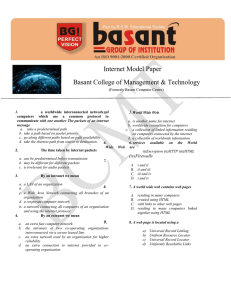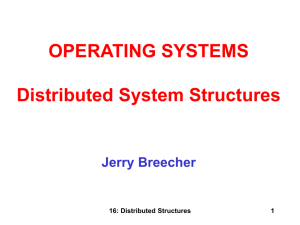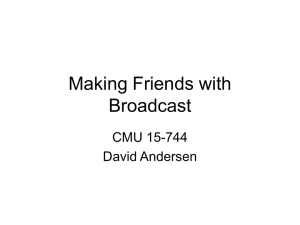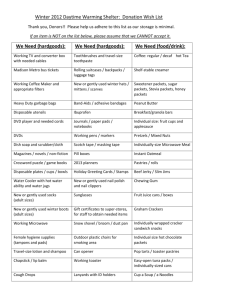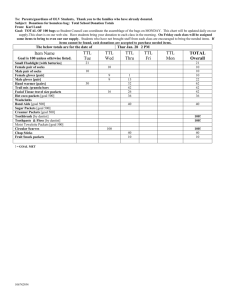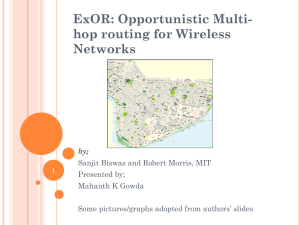PPT
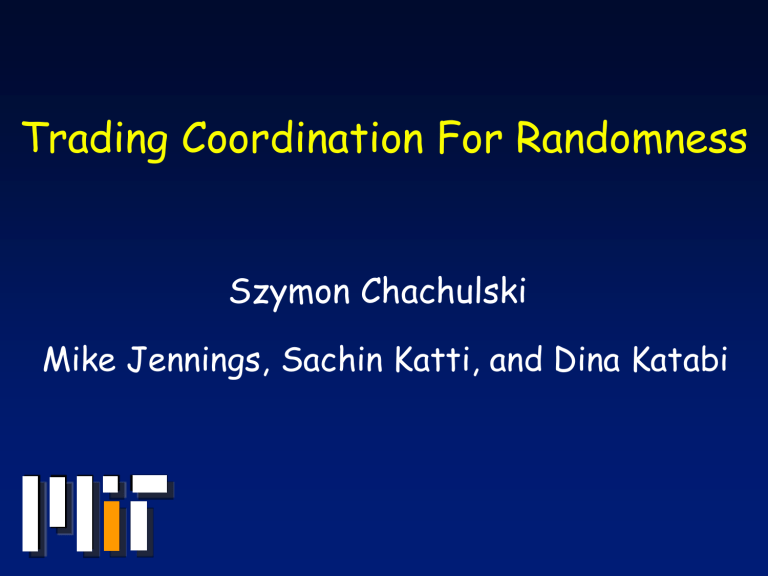
Trading Coordination For Randomness
Szymon Chachulski
Mike Jennings, Sachin Katti, and Dina Katabi
Wireless mesh networks have high loss rates
Roofnet
Avg. 30% loss
Objective:
High throughput despite lossy links
Use Opportunistic Routing
Use Opportunistic Routing
R1 src
50%
R2
R3
R4
• Best single path loss prob. 50% dst
Use Opportunistic Routing
R1 src
50%
R2
R3
R4 dst
Opportunistic routing promises large increase in throughput the packet can forward it loss prob. 0.5
4 = 6%
But
Overlap in received packets Routers forward duplicates
But
Overlap in received packets Routers forward duplicates
P
1
R1
P
2
P
1
P
2 src dst
P
10 R2
P
1
P
2
But
Overlap in received packets Routers forward duplicates
P
1
P
2 src
R1 dst
P
1
P
2
P
1
P
2
P
10 R2
State-of-the-art opp. routing, ExOR imposes a global scheduler:
- Requires full coordination; every node must know who received what
- Only one node transmits at a time, others listen
Global Scheduling?
src
• Global coordination is too hard
• One transmitter dst
src
Global Scheduling?
dst
Our Contributions
• Opportunistic routing with no global scheduler and no coordination
• We use random network coding
• Experiments show that randomness outperforms both current routing and ExOR
Go Random
Each router forwards random combinations of packets
Go Random
Each router forwards random combinations of packets
P
1
P 2
R1
α P 1 + ß P 2 src dst
P
1
P 2
R2 γ P 1 + δ P 2
Randomness prevents duplicates
No scheduler; No coordination
Simple and exploits spatial reuse
Random Coding Benefits Multicast
P
P
P
P
3
4
1
2 src dst1 dst2 dst3
P 1
P 2
P3
P4
P1
P 2
P 3
P4
P1
P2
P 3
P 4
Without coding source retransmits all 4 packets
Random Coding Benefits Multicast
P
P
P
P
3
4
1
2 src
Random combinations
8 P 1 +5 P 2 + P 3 +3 P 4
7 P 1 +3 P 2 +6 P 3 + P 4 dst1
P 1
P 2
P3
P4 dst2
P1
P 2
P 3
P4 dst3
P1
P2
P 3
P 4
MORE
MORE
• Source sends packets in batches
• Forwarders keep all heard packets in a buffer
• Nodes transmit linear combinations of buffered packets a P1 + b P2 + c P3 = a,b,c src
P2
P3
A B dst
4,1,3 4,1,3 sustain high throughput!
MORE
• Source sends packets in batches
• Forwarders keep all heard packets in a buffer
• Nodes transmit linear combinations of buffered packets a P1 + b P2 + c P3 = a,b,c src
P1
P2
P3
A
4,1,3
0,2,1
B
4,1,3
8,4,7 dst
8,4,7
2 4,1,3 + 1 0,2,1 = 8,4,7
MORE
• Source sends packets in batches
• Forwarders keep all heard packets in a buffer
• Nodes transmit linear combinations of buffered packets
• Destination decodes once it receives enough combinations
Say batch is 3 packets
1
5
4
P1 + 3
P1 + 4
P1 + 5
P2 + 2
P2 + 5
P2 + 5
P3 =
P3 =
P3 =
1,3,2
5,4,5
4,5,5
• Destination acks batch, and source moves to next batch
But How Do We Get the Most Throughput?
• Naïve approach transmits whenever 802.11 allows
A
If A and B have same information, it is more efficient for B to send it
B dst
Need a Method to Our Madness
Probabilistic Forwarding
A dst
B
Probabilistic Forwarding e1 e2
Loss rate 0%
Src
P1
P2
A
Loss rate 50%
B e1 dst
Probabilistic Forwarding
How many packets should I forward?
50% of buffer e1 e2
A dst
B
Src
P1
P2
?
Probabilistic Forwarding
Pr = 0.5
e1 e2
A dst
0%
Pr = 1
50%
B
Src
P1
Compute forwarding probabilities without coordination using loss rates
Can ExOR Use Probabilistic Forwarding To
Remove Coordination?
Pr = 0.5
A
P1
Probability of duplicates is 50%
P1
P2 dst
Pr = 1
• Without random coding need to know the exact packets to forward every time
• With random coding need to know only the average amount of overlap
Long-term averages are great, but…
Wireless is unpredictable over short time-scales
There are known knowns . These are things we know that we know. There are known unknowns . That is to say, there are things that we know we don't know. But there are also unknown unknowns .
MORE needs to adapt to short-term dynamics
Adapting to Short-term Dynamics
• Need to balance sent information with received information
• MORE triggers transmission by receptions
• A node has a credit counter
Upon reception, increment the counter using forwarding probabilities
Upon transmission, decrement the counter
• Source stops No triggers Flow is done
Performance
Experimental Setup
• We implemented MORE in Linux
• 20-node testbed
• Compare MORE with:
Current Routing (Single Best Path)
ExOR (State-of-the-art Opportunitic Routing)
• Experiment
Random source-destination pairs
Transmit 5 MB file
Testbed
• 20-node testbed over three floors
Testbed
• 20-node testbed over three floors
Avg. loss 27%
Does MORE Improve Wireless Throughput?
Avg. Throughput over 180 src-dst pairs [pkts/s]
MORE
80
ExOR
Current
40
MORE’s throughput is
• 2x better than current routing
• 22% better than ExOR
Throughput of All Source-Destination Pairs
CDF of 180 source-destination pairs
1
0.8
0.6
0.4
0.2
0
0 50 100
Throughput [packets/s]
Current
ExOR
MORE
150 200
1
0.9
0.8
0.7
0.5
0.4
0.3
0.2
0.1
0
4x
Current
ExOR
MORE
0 50
Throughput [packets/s]
100 150 200
1
0.75
0.5
0.25
0
0
Sensitivity to Batch Size
ExOR CDF MORE CDF
1
0.75
0.5
50
Batch = 8 pkts
Batch = 128 pkts
0.25
100 150
0
0 50
Batch = 8 pkts
Batch = 128 pkts
100 150
Throughput [packets/s]
What About Multicast?
Avg. Throughput Per Destination [pkts/s]
+200%
Current
MORE
+260%
100
+320%
50
MORE improves both multicast and unicast
2 destinations throughput 4 destinations
MORE for Less!
• Lesser coordination and lesser rigidity
No scheduler
• More flexibility
Works on top of 802.11 enjoy spatial reuse
One framework for unicast and multicast
• More throughput
22% better than ExOR
2x better than current routing

